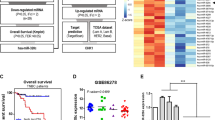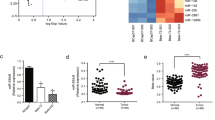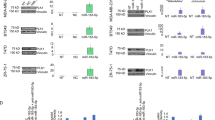Abstract
Acquired therapeutic resistance is the major drawback to effective systemic therapies for cancers. Aggressive triple-negative breast cancers (TNBC) develop resistance to chemotherapies rapidly, whereas the underlying mechanisms are not completely understood. Here we show that genotoxic treatments significantly increased the expression of miR-181a in TNBC cells, which enhanced TNBC cell survival and metastasis upon Doxorubicin treatment. Consistently, high miR-181a level associated with poor disease free survival and overall survival after treatments in breast cancer patients. The upregulation of miR-181a was orchestrated by transcription factor STAT3 whose activation depended on NF-κB-mediated IL-6 induction in TNBC cells upon genotoxic treatment. Intriguingly, activated STAT3 not only directly bound to MIR181A1 promoter to drive transcription but also facilitated the recruitment of MSK1 to the same region where MSK1 promoted a local active chromatin state by phosphorylating histone H3. We further identified BAX as a direct functional target of miR-181a, whose suppression decreased apoptosis and increased invasion of TNBC cells upon Dox treatment. These results were further confirmed by evidence that suppression of miR-181a significantly enhanced therapeutic response and reduced lung metastasis in a TNBC orthotopic model. Collectively, our data suggested that miR-181a induction had a critical role in promoting therapeutic resistance and aggressive behavior of TNBC cells upon genotoxic treatment. Antagonizing miR-181a may serve as a promising strategy to sensitize TNBC cells to chemotherapy and mitigate metastasis.
This is a preview of subscription content, access via your institution
Access options
Subscribe to this journal
Receive 50 print issues and online access
$259.00 per year
only $5.18 per issue
Buy this article
- Purchase on Springer Link
- Instant access to full article PDF
Prices may be subject to local taxes which are calculated during checkout







Similar content being viewed by others

References
Foulkes WD, Smith IE, Reis-Filho JS . Triple-Negative Breast Cancer. N Engl J Med 2010; 363: 1938–1948.
Carey L, Winer E, Viale G, Cameron D, Gianni L . Triple-negative breast cancer: disease entity or title of convenience? Nat Rev Clin Oncol 2010; 7: 683–692.
Wu ZH, Miyamoto S . Many faces of NF-kappaB signaling induced by genotoxic stress. J Mol Med 2007; 85: 1187–1202.
Baldwin AS . Regulation of cell death and autophagy by IKK and NF-κB: critical mechanisms in immune function and cancer. Immunol Rev 2012; 246: 327–345.
Boldin MP, Baltimore D . MicroRNAs: new effectors and regulators of NF-κB. Immunol Rev 2012; 246: 205–220.
Bartel DP . MicroRNAs: genomics, biogenesis, mechanism, and function. Cell 2004; 116: 281–297.
Ozsolak F, Poling LL, Wang Z, Liu H, Liu XS, Roeder RG et al. Chromatin structure analyses identify miRNA promoters. Genes Dev 2008; 22: 3172–3183.
Garzon R, Marcucci G, Croce CM . Targeting microRNAs in cancer: rationale, strategies and challenges. Nat Rev Drug Discov 2010; 9: 775–789.
Kasinski AL, Slack FJ . MicroRNAs en route to the clinic: progress in validating and targeting microRNAs for cancer therapy. Nat Rev Cancer 2011; 11: 849–864.
Garofalo M, Croce CM . MicroRNAs as therapeutic targets in chemoresistance. Drug Resist Updat 2013; 16: 47–59.
Ling H, Fabbri M, Calin GA . MicroRNAs and other non-coding RNAs as targets for anticancer drug development. Nat Rev Drug Discov 2013; 12: 847–865.
Kato M, Paranjape T, Muller RU, Nallur S, Gillespie E, Keane K et al. The mir-34 microRNA is required for the DNA damage response in vivo in C. elegans and in vitro in human breast cancer cells. Oncogene 2009; 28: 2419–2424.
Chaudhry MA, Sachdeva H, Omaruddin RA . Radiation-induced micro-RNA modulation in glioblastoma cells differing in DNA-repair pathways. DNA Cell Biol 2010; 29: 553–561.
He L, He X, Lim LP, de Stanchina E, Xuan Z, Liang Y et al. A microRNA component of the p53 tumour suppressor network. Nature 2007; 447: 1130–1134.
Zhang X, Wan G, Berger FG, He X, Lu X . The ATM Kinase Induces MicroRNA Biogenesis in the DNA Damage Response. Mol Cell 2011; 41: 371–383.
Niu J, Shi Y, Tan G, Yang CH, Fan M, Pfeffer LM et al. DNA damage induces NF-kappaB-dependent microRNA-21 upregulation and promotes breast cancer cell invasion. J Biol Chem 2012; 287: 21783–21795.
Tan G, Niu J, Shi Y, Ouyang H, Wu Z-H . NF-κB-dependent microRNA-125b upregulation promotes cell survival by targeting p38α upon UV radiation. J Biol Chem 2012; 287: 33036–33047.
McCool KW, Miyamoto S . DNA damage-dependent NF-kappaB activation: NEMO turns nuclear signaling inside out. Immunol Rev 2012; 246: 311–326.
Parikh A, Lee C, Joseph P, Marchini S, Baccarini A, Kolev V et al. microRNA-181a has a critical role in ovarian cancer progression through the regulation of the epithelial–mesenchymal transition. Nat Commun 2014; 5: 2977.
Hickey CJ, Schwind S, Radomska HS, Dorrance AM, Santhanam R, Mishra A et al. Lenalidomide-mediated enhanced translation of C/EBPα-p30 protein up-regulates expression of the antileukemic microRNA-181a in acute myeloid leukemia. Blood 2013; 121: 159–169.
Enerly E, Steinfeld I, Kleivi K, Leivonen S-K, Aure MR, Russnes HG et al. miRNA-mRNA Integrated Analysis Reveals Roles for miRNAs in Primary Breast Tumors. PLoS ONE 2011; 6: e16915.
Riaz M, van Jaarsveld MT, Hollestelle A, Prager-van der Smissen WJ, Heine AA, Boersma AW et al. miRNA expression profiling of 51 human breast cancer cell lines reveals subtype and driver mutation-specific miRNAs. Breast Cancer Res 2013; 15: R33.
Niu J, Shi Y, Xue J, Miao R, Huang S, Wang T et al. USP10 inhibits genotoxic NF-kappaB activation by MCPIP1-facilitated deubiquitination of NEMO. EMBO J 2013; 32: 3206–3219.
Sansone P, Bromberg J . Targeting the Interleukin-6/Jak/Stat pathway in human malignancies. J Clin Oncol 2012; 30: 1005–1014.
Yang CH, Yue J, Fan M, Pfeffer LM . IFN Induces miR-21 through a Signal transducer and activator of transcription 3–dependent pathway as a suppressive negative feedback on IFN-induced apoptosis. Cancer Res 2010; 70: 8108–8116.
Wakahara R, Kunimoto H, Tanino K, Kojima H, Inoue A, Shintaku H et al. Phospho-Ser727 of STAT3 regulates STAT3 activity by enhancing dephosphorylation of phospho-Tyr705 largely through TC45. Genes Cells 2012; 17: 132–145.
Baek Sung H . When signaling kinases meet histones and histone modifiers in the nucleus. Mol Cell 2011; 42: 274–284.
Gehani SS, Agrawal-Singh S, Dietrich N, Christophersen NS, Helin K, Hansen K . Polycomb group protein displacement and gene activation through MSK-dependent H3K27me3S28 phosphorylation. Mol Cell 2010; 39: 886–900.
Lau PN, Cheung P . Histone code pathway involving H3 S28 phosphorylation and K27 acetylation activates transcription and antagonizes polycomb silencing. Proc Natl Acad Sci USA 2011; 108: 2801–2806.
Ouyang Y-B, Lu Y, Yue S, Giffard RG . miR-181 targets multiple Bcl-2 family members and influences apoptosis and mitochondrial function in astrocytes. Mitochondrion 2012; 12: 213–219.
Cummins JM, He Y, Leary RJ, Pagliarini R, Diaz LA Jr., Sjoblom T et al. The colorectal microRNAome. Proc Natl Acad Sci USA 2006; 103: 3687–3692.
Györffy B, Lanczky A, Eklund A, Denkert C, Budczies J, Li Q et al. An online survival analysis tool to rapidly assess the effect of 22,277 genes on breast cancer prognosis using microarray data of 1,809 patients. Breast Cancer Res Treat 2010; 123: 725–731.
Minn AJ, Gupta GP, Siegel PM, Bos PD, Shu W, Giri DD et al. Genes that mediate breast cancer metastasis to lung. Nature 2005; 436: 518–524.
Yang J, Huang J, Dasgupta M, Sears N, Miyagi M, Wang B et al. Reversible methylation of promoter-bound STAT3 by histone-modifying enzymes. Proc Natl Acad Sci USA 2010; 107: 21499–21504.
Hedrich CM, Rauen T, Apostolidis SA, Grammatikos AP, Rodriguez Rodriguez N, Ioannidis C et al. Stat3 promotes IL-10 expression in lupus T cells through trans-activation and chromatin remodeling. Proc Natl Acad Sci USA 2014; 111: 13457–13462.
Bonnay F, Nguyen XH, Cohen‐Berros E, Troxler L, Batsche E, Camonis J et al. Akirin specifies NF-κB selectivity of Drosophila innate immune response via chromatin remodeling. EMBO J 2014; 33: 2349–2362.
Tartey S, Matsushita K, Vandenbon A, Ori D, Imamura T, Mino T et al. Akirin2 is critical for inducing inflammatory genes by bridging IκB‐ζ and the SWI/SNF complex. EMBO J 2014; 33: 2332–2348.
Sawicka A, Hartl D, Goiser M, Pusch O, Stocsits RR, Tamir I et al. H3S28 phosphorylation is a hallmark of the transcriptional response to cellular stress. Genome Res 2014; 24: 1808–1820.
Galluzzi L, Morselli E, Vitale I, Kepp O, Senovilla L, Criollo A et al. miR-181a and miR-630 regulate cisplatin-induced cancer cell death. Cancer Research 2010; 70: 1793–1803.
Jiao X, Zhao L, Ma M, Bai X, He M, Yan Y et al. MiR-181a enhances drug sensitivity in mitoxantone-resistant breast cancer cells by targeting breast cancer resistance protein (BCRP/ABCG2). Breast Cancer Res Treat 2013; 139: 717–730.
Chen Y, Ke G, Han D, Liang S, Yang G, Wu X . MicroRNA-181a enhances the chemoresistance of human cervical squamous cell carcinoma to cisplatin by targeting PRKCD. Exp Cell Res 2014; 320: 12–20.
Liu M, Wang J, Huang H, Hou J, Zhang B, Wang A . miR-181a–Twist1 pathway in the chemoresistance of tongue squamous cell carcinoma. Biochem Biophys Res Commun 2013; 441: 364–370.
Ouyang M, Li Y, Ye S, Ma J, Lu L, Lv W et al. MicroRNA profiling implies new markers of chemoresistance of triple-negative breast cancer. PLoS ONE 2014; 9: e96228.
Llambi F, Moldoveanu T, Tait Stephen WG, Bouchier-Hayes L, Temirov J, McCormick Laura L et al. A unified model of mammalian BCL-2 protein family interactions at the mitochondria. Mol Cell 2011; 44: 517–531.
Taylor MA, Sossey-Alaoui K, Thompson CL, Danielpour D, Schiemann WP . TGF-beta upregulates miR-181a expression to promote breast cancer metastasis. J Clin Invest 2013; 123: 150–163.
Wang Y, Yu Y, Tsuyada A, Ren X, Wu X, Stubblefield K et al. Transforming growth factor-[beta] regulates the sphere-initiating stem cell-like feature in breast cancer through miRNA-181 and ATM. Oncogene 2011; 30: 1470–1480.
Ji D, Chen Z, Li M, Zhan T, Yao Y, Zhang Z et al. MicroRNA-181a promotes tumor growth and liver metastasis in colorectal cancer by targeting the tumor suppressor WIF-1. Mol Cancer 2014; 13: 86.
Zhou W, Fong Miranda Y, Min Y, Somlo G, Liu L, Palomares MR et al. Cancer-secreted miR-105 destroys vascular endothelial barriers to promote metastasis. Cancer Cell 2014; 25: 501–515.
Fan M, Krutilina R, Sun J, Sethuraman A, Yang CH, Wu Z-h et al. Comprehensive analysis of MicroRNA (miRNA) targets in breast cancer cells. J Biol Chem 2013; 288: 27480–27493.
Acknowledgements
We thank Dr Bert Vogelstein (Johns Hopkins University) for wild-type and DICER−/− HCT116 cells. The BAX expression construct was a generous gift from Dr Douglas Green (St Jude Children’s Research Hospital). We also thank Dr R. Laribee (UTHSC) for stimulating discussion and critical reading of the manuscript. This work was supported in part by grants from National Cancer Institute (R01 CA149251 to ZW), American Cancer Society (RSG-13-186-01-CSM to ZW), and National Natural Science Foundation of China (NSFC) (81272924 to JW).
Author information
Authors and Affiliations
Corresponding authors
Ethics declarations
Competing interests
The authors declare no conflict of interest.
Additional information
Supplementary Information accompanies this paper on the Oncogene website
Supplementary information
Rights and permissions
About this article
Cite this article
Niu, J., Xue, A., Chi, Y. et al. Induction of miRNA-181a by genotoxic treatments promotes chemotherapeutic resistance and metastasis in breast cancer. Oncogene 35, 1302–1313 (2016). https://doi.org/10.1038/onc.2015.189
Received:
Revised:
Accepted:
Published:
Issue Date:
DOI: https://doi.org/10.1038/onc.2015.189
This article is cited by
-
IKKα inhibition re-sensitizes acquired adriamycin-resistant triple negative breast cancer cells to chemotherapy-induced apoptosis
Scientific Reports (2023)
-
The miR-106b-25 cluster mediates drug resistance in myeloid leukaemias by inactivating multiple apoptotic genes
International Journal of Hematology (2023)
-
Role of inflammatory microenvironment: potential implications for improved breast cancer nano-targeted therapy
Cellular and Molecular Life Sciences (2021)
-
Breast Cancer Response to Therapy: Can microRNAs Lead the Way?
Journal of Mammary Gland Biology and Neoplasia (2021)
-
MiR-181a and -b expression in acute lymphoblastic leukemia and its correlation with acute graft-versus-host disease after hematopoietic stem cell transplantation, COVID-19 and torque teno viruses
VirusDisease (2021)


